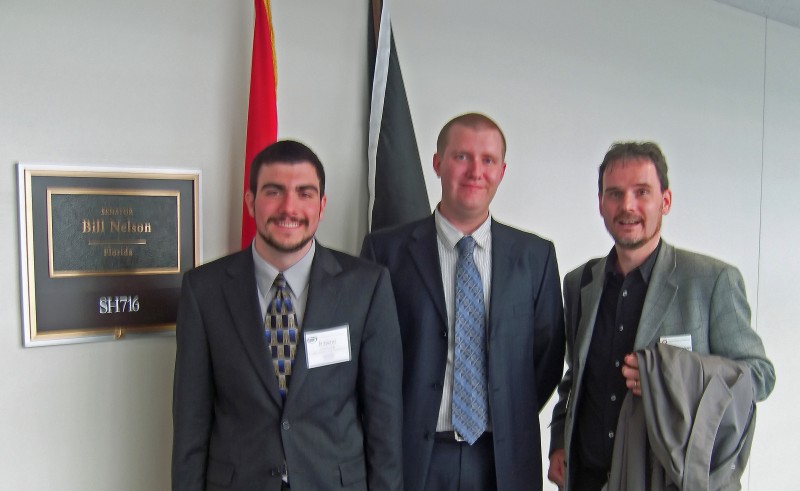Physics majors detect nuclear contraband through muon research
by Michael Staib, Physics ‘12
So, what exactly is a muon and why are you researching them?
A muon can be thought of as a heavy electron. These particles are produced in the upper atmosphere and are constantly passing though us on the surface of the earth. A muon can pass through tens of meters of steel without being absorbed. If we look at the amount by which a muon is deflected within some unknown material, we can try to determine what the material was that caused the muon to deflect. This has several applications including detection of nuclear contraband (i.e uranium, plutonium) that has been shielded to prevent detection by conventional techniques that search for the radiological signatures emitted from these materials.
How did you get started researching muons?
I first heard about the idea of muon tomography from Dr. Hohlmann when I was a undergraduate pursuing my physics degree. To be fair, we don’t really research muons in the sense of investigating the particle itself. We research how we can exploit the properties of cosmic-ray muons in an interesting way. I always enjoyed research with a hands-on component so the project was a natural fit. The project has allowed me to work directly on hardware while at the same time being responsible for a large amount of the coding associated with the data acquisition and analysis.
Where are you building your muon detector and can you tell us a little bit about that process?
Muon tomography relies not only on a single muon detector but instead on a collection of muon detectors that form a muon tracker. We measure the path a muon takes in order to extract the information that we need. The type of detector that we use is called a GEM (Gas Electron Multiplier) detector. The GEM detector components are built at CERN. We assembled eight detectors at CERN and two detectors at Florida Tech using these components. The assembly requires carefully stretching and gluing the delicate GEM layers onto frames that provide structural support. I helped to develop a novel stretching technique using heat lamps that we used to assemble two GEM detectors in clean room conditions here at FIT.
Are any other students involved with this research or build?
The project has been ongoing since 2007 so there has been quite a lot of combined effort to reach our goal of a working prototype. Since I have been with the group, I have worked with many students, including; Kondo Gnanvo, Lenny Grasso, Amilkar Quintero, Bryant Benson, Ben Locke, Vallary Bhopatkar, Jessie Twigger, just to name a few. Our research group is quite large and is mostly comprised of undergraduates. This past semester the group consisted of Dr. Hohlmann, four graduate students including myself, and twelve undergraduates who all took part in some of the research. See our group website for more details: http://research.fit.edu/hep_labA/
What advice can you offer budding scientists who are looking at creating their own instrumentation?
I’d suggest starting research early in your college career. You can learn many valuable skills working in a lab that you will never learn from a book. If you think you might be interested in something, give it a shot. Don’t be afraid of failure; it tends to happen often in research and development. Learn from your mistakes.
Do you feel that your advisors or professors have been supportive of your endeavors?
My advisor has been extremely supportive of my research here at FIT. I have had the opportunity to travel to CERN to take part in the commissioning of our Muon Tomography station, as well as to several regional and national conferences to present our research. None of this would have been possible without Dr. Hohlmann’s support and guidance.
You can read more about Mike’s research in the Economist and a recent Florida Tech press release.





